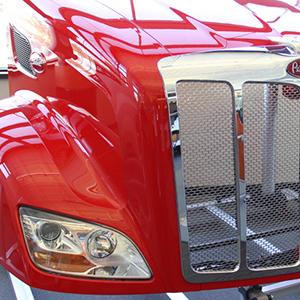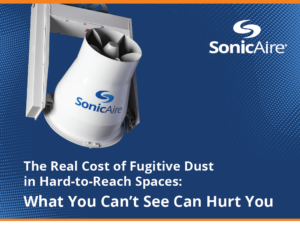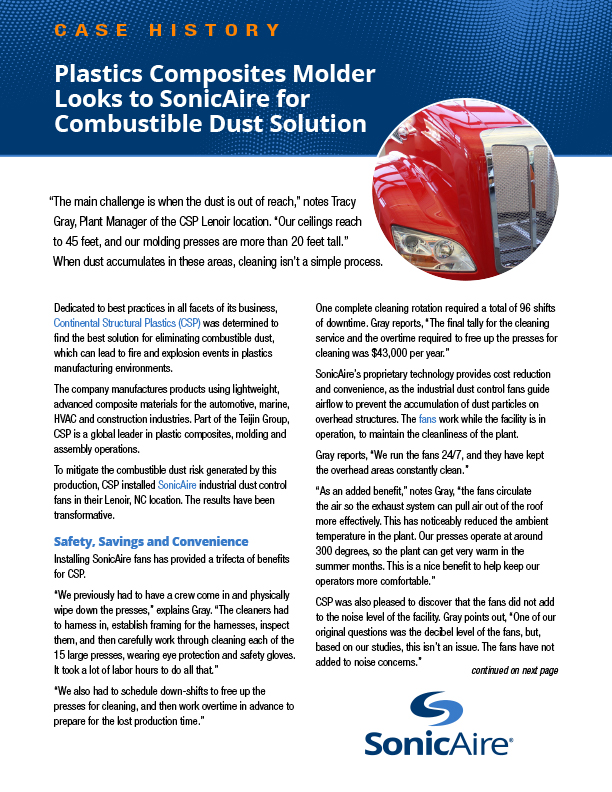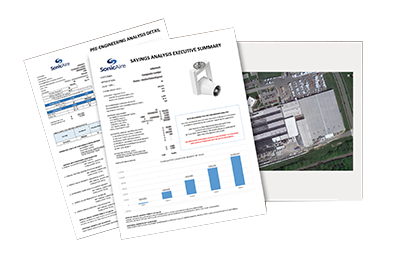 Continental Structural Plastics
Continental Structural Plastics
Dedicated to best practices in all facets of its business, Continental Structural Plastics (CSP) was determined to find the best solution for eliminating combustible dust, which can lead to fire and explosion events in plastics manufacturing environments.
“The main challenge is when the dust is out of reach,” notes Tracy Gray, Plant Manager of the Lenoir, NC facility. “We had a housekeeping program in place, but our ceilings reach heights of 45 feet, and our molding presses are more than 20 feet tall.” When dust accumulates in these areas, cleaning isn’t a simple process.
“We had to have a crew come in and physically wipe down the presses,” explains Gray. “They had to harness in and then work through cleaning each of the 15 presses, wearing eye protection and safety gloves. We also had to schedule down-shifts to free up the presses for this cleaning, and then work overtime in advance to prepare for lost production time.”
CSP installed SonicAire industrial dust control fans in the Lenoir plant. The results have provided a trifecta of benefits for CSP.
SonicAire’s proprietary technology provides cost reduction and convenience. The fans work while the plant is in operation, to maintain the cleanliness of the plant. Gray reports, “We run the fans 24/7, and they have kept the overhead areas constantly clean.”
“As an added benefit,” notes Gray, “the fans circulate the air so the exhaust system can pull air out of the roof more effectively. This has noticeably reduced the ambient temperature in the plant. This is a nice benefit to help keep our operators more comfortable.”
 Continental Structural Plastics
Continental Structural Plastics
Dedicated to best practices in all facets of its business, Continental Structural Plastics (CSP) was determined to find the best solution for eliminating combustible dust, which can lead to fire and explosion events in plastics manufacturing environments.
“The main challenge is when the dust is out of reach,” notes Tracy Gray, Plant Manager of the Lenoir, NC facility. “We had a housekeeping program in place, but our ceilings reach heights of 45 feet, and our molding presses are more than 20 feet tall.” When dust accumulates in these areas, cleaning isn’t a simple process.
“We had to have a crew come in and physically wipe down the presses,” explains Gray. “They had to harness in and then work through cleaning each of the 15 presses, wearing eye protection and safety gloves. We also had to schedule down-shifts to free up the presses for this cleaning, and then work overtime in advance to prepare for lost production time.”
CSP installed SonicAire industrial dust control fans in the Lenoir plant. The results have provided a trifecta of benefits for CSP.
SonicAire’s proprietary technology provides cost reduction and convenience. The fans work while the plant is in operation, to maintain the cleanliness of the plant. Gray reports, “We run the fans 24/7, and they have kept the overhead areas constantly clean.”
“As an added benefit,” notes Gray, “the fans circulate the air so the exhaust system can pull air out of the roof more effectively. This has noticeably reduced the ambient temperature in the plant. This is a nice benefit to help keep our operators more comfortable.”

GET YOUR FREE GUIDE:
The Real Cost of Fugitive Dust in Hard-to-Reach Spaces
What You Can’t See Can Hurt You
To help protect your workplace, we’ve compiled the following resource, The Real Cost of Fugitive Dust in Hard-to-Reach Spaces: What You Can’t See Can Hurt You. In it, we identify seven ways fugitive dust is likely impacting your facility and its profitability.
These costs go beyond housekeeping and explain why you should be preventing dust buildup to protect the bottom line, not just to stay in compliance.


